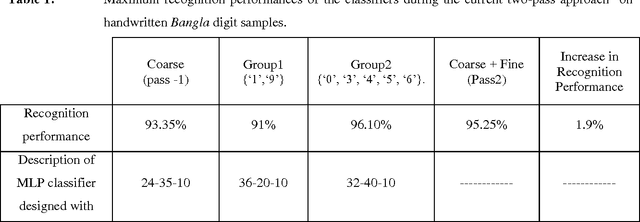Punam Kumar Saha
A GA Based approach for selection of local features for recognition of handwritten Bangla numerals
Jan 22, 2015


Abstract:Soft computing approaches are mainly designed to address the real world ill-defined, imprecisely formulated problems, combining different kind of novel models of computation, such as neural networks, genetic algorithms (GAs. Handwritten digit recognition is a typical example of one such problem. In the current work we have developed a two-pass approach where the first pass classifier performs a coarse classification, based on some global features of the input pattern by restricting the possibility of classification decisions within a group of classes, smaller than the number of classes considered initially. In the second pass, the group specific classifiers concentrate on the features extracted from the selected local regions, and refine the earlier decision by combining the local and the global features for selecting the true class of the input pattern from the group of candidate classes selected in the first pass. To optimize the selection of local regions a GA based approach has been developed here. The maximum recognition performance on Bangla digit samples as achieved on the test set, during the first pass of the two pass approach is 93.35%. After combining the results of the two stage classifiers, an overall success rate of 95.25% is achieved.
Design of a novel convex hull based feature set for recognition of isolated handwritten Roman numerals
Jan 22, 2015

Abstract:In this paper, convex hull based features are used for recognition of isolated Roman numerals using a Multi Layer Perceptron (MLP) based classifier. Experiments of convex hull based features for handwritten character recognition are few in numbers. Convex hull of a pattern and the centroid of the convex hull both are affine invariant attributes. In this work, 25 features are extracted based on different bays attributes of the convex hull of the digit patterns. Then these patterns are divided into four sub-images with respect to the centroid of the convex hull boundary. From each such sub-image 25 bays features are also calculated. In all 125 convex hull based features are extracted for each numeric digit patterns under the current experiment. The performance of the designed feature set is tested on the standard MNIST data set, consisting of 60000 training and 10000 test images of handwritten Roman using an MLP based classifier a maximum success rate of 97.44% is achieved on the test data.
Recognition of Handwritten Bangla Basic Characters and Digits using Convex Hull based Feature Set
Oct 02, 2014



Abstract:In dealing with the problem of recognition of handwritten character patterns of varying shapes and sizes, selection of a proper feature set is important to achieve high recognition performance. The current research aims to evaluate the performance of the convex hull based feature set, i.e. 125 features in all computed over different bays attributes of the convex hull of a pattern, for effective recognition of isolated handwritten Bangla basic characters and digits. On experimentation with a database of 10000 samples, the maximum recognition rate of 76.86% is observed for handwritten Bangla characters. For Bangla numerals the maximum success rate of 99.45%. is achieved on a database of 12000 sample. The current work validates the usefulness of a new kind of feature set for recognition of handwritten Bangla basic characters and numerals.
 Add to Chrome
Add to Chrome Add to Firefox
Add to Firefox Add to Edge
Add to Edge